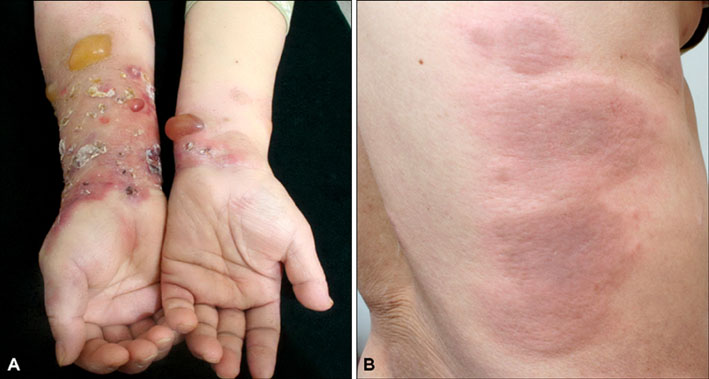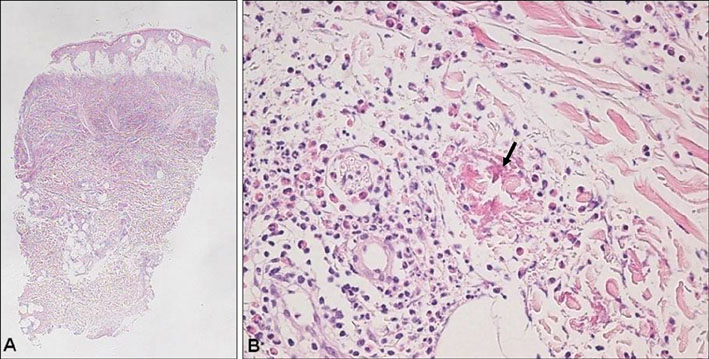Ann Dermatol.
2011 Nov;23(4):497-500.
Wells' Syndrome Associated with Churg-Strauss Syndrome
- Affiliations
-
- 1Department of Dermatology and Cutaneous Biology Research Institute, Yonsei University College of Medicine, Korea.
- 2Yeouido Oracle Cosmetic & Dermatologic Surgery Clinic, Seoul, Korea. iris980@hanmail.net
Abstract
- Churg-Strauss syndrome (CSS) is a multisystem granulomatous vasculitis that is characterized by peripheral eosinophilia and the infiltration of eosinophils into systemic organs. The skin lesions of CSS consist mainly of palpable purpura and nodules. Wells' syndrome (WS) is a rare inflammatory dermatosis that is associated with recurrent granulomatous dermatitis and eosinophilia. Since these two diseases are rare, any overlap between them is very unusual. Herein, we report a patient with CSS, who initially presented a skin eruption of erythematous urticarial-plaques, vesicles, and blisters. Upon biopsy, the histology of these plaques indicated eosinophilic infiltration and "flame figures" within the dermis, which was consistent with a diagnosis of WS. Although the association between WS and CSS that was observed in our patient may be purely coincidental, it could also suggest a common pathogenetic background of these two distinct diseases, as both share several many common features.
MeSH Terms
Figure
Reference
-
1. Wells GC, Smith NP. Eosinophilic cellulitis. Br J Dermatol. 1979. 100:101–109.
Article2. Schuttelaar ML, Jonkman MF. Bullous eosinophilic cellulitis (Well's syndrome) associated with Churg-Strauss syndrome. J Eur Acad Dermatol Venereol. 2003. 17:91–93.
Article3. Lee SC, Shin SS, Lee JB, Won YH. Wells syndrome associated with Churg-Strauss syndrome. J Am Acad Dermatol. 2000. 43:556–557.
Article4. Govoni M, Colina M, Cavazzini L, Trotta F. Churg-Strauss syndrome and Wells syndrome: coincidence or pathogenetic association? A new case report. Clin Exp Rheumatol. 2007. 25:1 Suppl 44. S41.5. Fujimoto N, Wakabayashi M, Kato T, Nishio C, Tanaka T. Wells syndrome associated with Churg-Strauss syndrome. Clin Exp Dermatol. 2011. 36:46–48.6. Masi AT, Hunder GG, Lie JT, Michel BA, Bloch DA, Arend WP, et al. The American College of Rheumatology 1990 criteria for the classification of Churg-Strauss syndrome (allergic granulomatosis and angiitis). Arthritis Rheum. 1990. 33:1094–1100.
Article7. Katoulis AC, Bozi E, Samara M, Kalogeromitros D, Panayiotides I, Stavrianeas NG. Idiopathic bullous eosinophilic cellulitis (Well's syndrome). Clin Exp Dermatol. 2009. 34:e375–e376.
Article8. Caputo R, Marzano AV, Vezzoli P, Lunardon L. Wells syndrome in adults and children: a report of 19 cases. Arch Dermatol. 2006. 142:1157–1161.9. Gilliam AE, Bruckner AL, Howard RM, Lee BP, Wu S, Frieden IJ. Bullous "cellulitis" with eosinophilia: case report and review of Well's syndrome in childhood. Pediatrics. 2005. 116:e149–e155.
Article10. Churg J, Strauss L. Allergic granulomatosis, allergic angiitis, and periarteritis nodosa. Am J Pathol. 1951. 27:277–301.11. Kallenberg CG. Churg-Strauss syndrome: just one disease entity. Arthritis Rheum. 2005. 52:2589–2593.
Article
- Full Text Links
- Actions
-
Cited
- CITED
-
- Close
- Share
- Similar articles
-
- A case of Churg-Strauss syndrome that underwent endoscopic sinus surgery under total intravenous anesthesia: A case report
- Eosinophilic Annular Erythema in a Patient with Eosinophilic Granulomatosis with Polyangiitis (Churg-Strauss Syndrome)
- A Case of Churg-Strauss Syndrome Presenting Umbilicated Ulcerative Papules
- A Case of Churg-Strauss Syndrome with Endomyocardial Fibrosis
- A Case of Chrug-Strauss Syndrome Complicated with Intestinal Perforation



